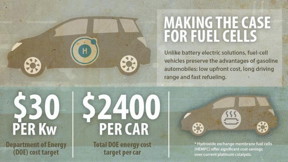Home > Press > It's basic: Alternative fuel cell technology reduces cost: Study sets performance targets for metal-free fuel cell membrane
 |
| Fuel-cell vehicles offer several advantages over battery-powered cars, but costs have been an obstacle. A new paper shows how an alternative technology could give fuel cells greater traction in the quest for zero-emissions vehicles. CREDIT UNIVERSITY OF DELAWARE/Jeffrey Chase |
Abstract:
The pathway to zero-emission vehicles has taken two forks, one toward battery electric cars like the Tesla and the other toward fuel-cell-powered automobiles like the Toyota Mirai.
It's basic: Alternative fuel cell technology reduces cost: Study sets performance targets for metal-free fuel cell membrane
Newark, DE | Posted on December 13th, 2016The University of Delaware's Yushan Yan believes that fuel-cell vehicles are the way to go, because they best preserve the advantages of gasoline automobiles: low upfront cost, long driving range and fast refueling.
But he also believes that a new fuel-cell technology may be necessary.
For Yan, that approach is a new twist on traditional fuel cells, known as proton exchange membrane fuel cells, or PEMFCs, which rely on costly platinum-based catalysts. Yan and his research team are pursuing an alternative technology, the hydroxide exchange membrane fuel cell (HEMFC), because of its inherent cost advantages.
He sees the rationale for this proposed switch as a matter of very simple arithmetic.
"To make fuel-cell cars a reality, the DOE (Department of Energy) has set a system cost target of $30 per kilowatt, which translates into about $2,400 per car," he says. "Right now, the cost for PEMFCs is $52 per kilowatt, which is a big improvement over where the technology started."
"But the catalyst accounts for only about $12 of that total, leaving $40 worth of other components. So even if we throw in some magic, we can't get the rest of the way down to the target of $30 with PEMFCs."
Yan is co-author on a new paper published in the online version of Nature Nanotechnology that he views as a roadmap to a unified strategy for HEMFC zero-emission cars based on three arguments.
"First, to become a commercial reality, fuel-cell engines have to be at cost parity with their gasoline counterparts," he says, "and moving from an acid platform with the PEMFC to a base system with the HEMFC will enable a collateral benefit in bringing down all of the associated costs.
"Then, if we agree that this is the best approach, we need to get everyone in the HEMFC research community on board. If we want to succeed, we have to work together."
Finally, Yan warns that it is insufficient just to have a lower cost.
"It doesn't work to compare our results today with those from yesterday or the day before," he says. "To succeed commercially with HEMFCs, we have to match or beat the performance of PEMFCs. It's that simple -- we can't succeed without achieving performance parity."
###
Yan is Distinguished Engineering Professor in UD's Department of Chemical and Biomolecular Engineering, Setzler is a postdoctoral researcher in Yan's group, and Wittkopf is a doctoral student advised by Yan.
Zhuang is a professor at Beijing University of Chemical Technology and a former postdoctoral researcher in Yan's group.
####
For more information, please click here
Contacts:
Peter Bothum
302-831-1418
Copyright © University of Delaware
If you have a comment, please Contact us.Issuers of news releases, not 7th Wave, Inc. or Nanotechnology Now, are solely responsible for the accuracy of the content.
| Related Links |
| Related News Press |
Discoveries
![]() Chemical reactions can scramble quantum information as well as black holes April 5th, 2024
Chemical reactions can scramble quantum information as well as black holes April 5th, 2024
![]() New micromaterial releases nanoparticles that selectively destroy cancer cells April 5th, 2024
New micromaterial releases nanoparticles that selectively destroy cancer cells April 5th, 2024
![]() Utilizing palladium for addressing contact issues of buried oxide thin film transistors April 5th, 2024
Utilizing palladium for addressing contact issues of buried oxide thin film transistors April 5th, 2024
Announcements
![]() NRL charters Navy’s quantum inertial navigation path to reduce drift April 5th, 2024
NRL charters Navy’s quantum inertial navigation path to reduce drift April 5th, 2024
![]() Discovery points path to flash-like memory for storing qubits: Rice find could hasten development of nonvolatile quantum memory April 5th, 2024
Discovery points path to flash-like memory for storing qubits: Rice find could hasten development of nonvolatile quantum memory April 5th, 2024
Interviews/Book Reviews/Essays/Reports/Podcasts/Journals/White papers/Posters
![]() Simulating magnetization in a Heisenberg quantum spin chain April 5th, 2024
Simulating magnetization in a Heisenberg quantum spin chain April 5th, 2024
![]() Discovery points path to flash-like memory for storing qubits: Rice find could hasten development of nonvolatile quantum memory April 5th, 2024
Discovery points path to flash-like memory for storing qubits: Rice find could hasten development of nonvolatile quantum memory April 5th, 2024
Automotive/Transportation
![]() Researchers’ approach may protect quantum computers from attacks March 8th, 2024
Researchers’ approach may protect quantum computers from attacks March 8th, 2024
![]() Tests find no free-standing nanotubes released from tire tread wear September 8th, 2023
Tests find no free-standing nanotubes released from tire tread wear September 8th, 2023
Fuel Cells
![]() Current and Future Developments in Nanomaterials and Carbon Nanotubes: Applications of Nanomaterials in Energy Storage and Electronics October 28th, 2022
Current and Future Developments in Nanomaterials and Carbon Nanotubes: Applications of Nanomaterials in Energy Storage and Electronics October 28th, 2022
|
|
||
|
|
||
| The latest news from around the world, FREE | ||
|
|
||
|
|
||
| Premium Products | ||
|
|
||
|
Only the news you want to read!
Learn More |
||
|
|
||
|
Full-service, expert consulting
Learn More |
||
|
|
||








